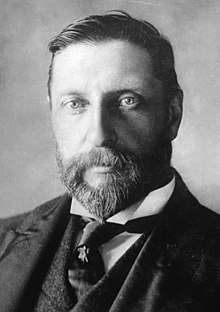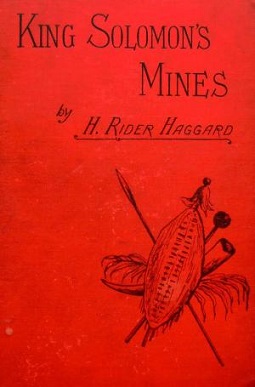
Grab A Book Right Over
HERE
H.Rider Haggard who had a birthday this weekend is considered the father of the modern adventure story and novel by many. His works have been translated numerous times, his characters are timeless and have been used as recently as Allen Moore's League of Extraordinary Gentlemen graphic novels. His character Allen Quartermain is the proto type for Indiana Jones and his death traps have been the inspiration for countless DM's.
The H.Rider Haggard practically invented various types of death traps that have been used throughout countless D&D adventures over the years. His lost worlds have inspired, been ripped off, and copied numerous times through out the life of D&D and its various editions. Haggard remains timeless and continues to hold influence over a many a DM or game creator alike. He remains one of my favorite authors. Simple to pick up and hard to put down.
According to Wiki :
Sir Henry Rider Haggard, KBE (/ˈhæɡərd/; 22 June 1856 – 14 May 1925) was an English writer of adventure novels set in exotic locations, predominantly Africa, and a founder of the Lost World literary genre.[1] He was also involved in agricultural reform throughout the British Empire. His stories, situated at the lighter end of Victorian literature, continue to be popular and influential.
Haggard's stories are still widely read today. Ayesha, the female protagonist of She, has been cited as a prototype by psychoanalysts such as Sigmund Freud (in The Interpretation of Dreams) and Carl Jung. Her epithet "She Who Must Be Obeyed" is used by British author John Mortimer in his Rumpole of the Bailey series as the private name which the lead character uses for his wife, Hilda, before whom he trembles at home (despite the fact that he is a barrister with some skill in court). Haggard's Lost World genre influenced popular American pulp writers such as Edgar Rice Burroughs, Robert E. Howard, Talbot Mundy, Philip José Farmer, and Abraham Merritt.[26] Allan Quatermain, the adventure hero of King Solomon's Mines and its sequel Allan Quatermain, was a template for the American character Indiana Jones, featured in the films Raiders of the Lost Ark, Temple of Doom, Indiana Jones and the Last Crusade, [28] Quatermain has gained recent popularity thanks to being a main character in the League of Extraordinary Gentlemen.

Haggard was praised in 1965 by Roger Lancelyn Green, one of the Oxford Inklings, as a writer of a consistently high level of "literary skill and sheer imaginative power" and a co-originator with Robert Louis Stevenson of the Age of the Story Tellers.[29]
The first chapter of his book People of the Mist is credited with inspiring the motto of the Royal Air Force (formerly the Royal Flying Corps), Per ardua ad astra.[30
You can read more about Haggard right over HERE
King Solomon's Mines

You can read more about Haggard right over HERE
King Solomon's Mines

The number of times that I've used the location for King Solomon's Mines is far to numerous for many an OD&D game. The location, plot, and substance of the novel are far too good to pass up over the years. There are far too many elements that can be adapted from the books of Haggard.


The basic plot of King Solomon's Mines according to wiki :
Allan Quatermain, an adventurer and white hunter based in Durban, in what is now South Africa, is approached by aristocrat Sir Henry Curtis and his friend Captain Good, seeking his help finding Sir Henry's brother, who was last seen travelling north into the unexplored interior on a quest for the fabled King Solomon's Mines. Quatermain has a mysterious map purporting to lead to the mines, but had never taken it seriously. However, he agrees to lead an expedition in return for a share of the treasure, or a stipend for his son if he is killed along the way. He has little hope they will return alive, but reasons that he has already outlived most people in his profession, so dying in this manner at least ensures that his son will be provided for. They also take along a mysterious native, Umbopa, who seems more regal, handsome and well-spoken than most porters of his class, but who is very anxious to join the party.
All of the elements of a proto D&D style party of adventurers are in the book and the lost world civilization are all right there between the pages.

As for the cries of racism and exploitation and other less savory aspects of the novel wiki had this to say :
The book has scholarly value for the colonialist attitudes Haggard expresses,[17] and for the way he portrays the relationships among the white and African characters. While Haggard does indeed portray some Africans (such as Twala and Gagool) in their traditional (for Victorian literature) literary posts as barbarians, he also presents the other side of the coin, showing some black Africans as heroes and heroines (such as Ignosi), and shows respect for their culture. Although the book is certainly not devoid of racism, it expresses much less prejudice than some of the later books in this genre. Indeed, Quatermain states that he refuses to use the word "nigger" and that many Africans are more worthy of the title of "gentleman" than the Europeans who settle or adventure in the country.[18] Haggard even includes an interracial romance between a Kukuana woman, Foulata, and the white Englishman Captain Good. The narrator tries to discourage the relationship, dreading the uproar such a marriage would cause back home in England; however, he has no objection to the lady, whom he considers very beautiful and noble. Haggard soon "kills off" Foulata, but has her die in Good's arms.
Kukuanaland is said in the book to be forty leagues north of the Lukanga river in modern Zambia, which would place it in the extreme south-east of the Democratic Republic of Congo. The culture of the Kukuanas shares many attributes with other South African tribes, such as Zulu being spoken and the kraal system being used.
There's a digital download of the first edition of the 1901 version of the book right over at the Internet Archive. Right over HERE
King Solomon's Mines remains a great source by an author who is mostly forgotten these days. This gives a DM a very broad pallet of material to work with and draw from. There's a ton that can be done with H.Rider Haggard's novels for your old school D&D games.
King Solomon's Mines remains a great source by an author who is mostly forgotten these days. This gives a DM a very broad pallet of material to work with and draw from. There's a ton that can be done with H.Rider Haggard's novels for your old school D&D games.
Nice to see this post. Haggard has some great novels. There's a lot of adventure-fodder contained in any one of his works, enough to keep someone busy for quite a while. Have you watched the movie adaptation of King Solomon's Mines?
ReplyDeleteThere are tons of material in Haggard's novels and such.
ReplyDeleteI have seen several of the movie adaptations of King Solomon's Mines, some better then others. I prefer some of the 1970's adaptations to the later 80's ones but as always mileage may vary. Thanks for the comments and more material coming up.